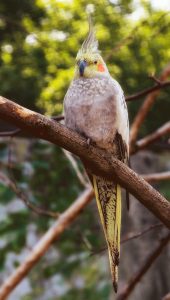I’ve always been fascinated by the vibrant personality of cockatiels and their array of behaviors that seem almost human at times. If you’re considering a feathered friend or just curious, you might wonder, “what are common cockatiel behaviors?” From their charming head bobs to the sometimes perplexing night frights, these birds are full of surprises.
Understanding these behaviors is not just about amusement—it’s crucial for their care. Cockatiels display a range of actions that can tell you a lot about their health and happiness. Let’s dive into the world of cockatiels and decode what their actions might mean, setting you on a path to becoming a more informed and empathetic pet owner.
What Are Common Cockatiel Behaviors?
Exploring the behaviors of cockatiels is key to maintaining their health and enhancing the bond they share with their owners. From distinct vocalizations to expressive body language, recognizing these signs enhances how we interact with these engaging pet birds.
Vocalizations and Their Meanings
Cockatiel vocalizations serve as an essential communication tool among these social birds. Decoding their sounds can provide insights into their emotional state and needs:
- Singing and Whistling: Generally exhibited by male cockatiels, these behaviors often signify happiness or a desire to attract attention. Singing might increase when they hear music or other birds.
- Hissing: This sound usually indicates fear, discomfort, or territoriality, especially if a stranger or another pet approaches their cage.
- Beak Grinding: Often heard when cockatiels are feeling content and relaxed, typically right before they fall asleep. It’s a sign of a healthy cockatiel gearing down for a good night’s rest.
- Contact Calls: If separated from their flock or human family members, cockatiels may make loud calls to locate others and ensure the group’s cohesion.
Each vocal cue helps owners understand their pet’s feelings and needs, enabling them to respond more effectively to keep their cockatiel happy.
Body Language Interpretation
Body language in cockatiels can be quite expressive, providing clear indicators of their mood and health status:
- Raised Crest: When a cockatiel’s crest feathers stand up, it indicates curiosity, excitement, or alertness. It’s important to observe what triggers this reaction to understand their interest or concern.
- Flattened Crest: Conversely, a flattened crest along with sleeked back feathers may signal fear or aggression. This can occur in situations of high stress or discomfort.
- Tail Feathers: The positioning and movement of tail feathers also convey emotions. Tail fanning and shaking could mean the cockatiel is happy and comfortable in its environment.
- Wing Flapping: Wing flapping while perched might be a way to exercise or express pleasure. However, if accompanied by vocal distress signals, it could indicate discomfort or a need for more space.
Understanding these behaviors not only aids in fostering a stronger bond with cockatiels but also assists in monitoring their welfare, ensuring they live a full, engaged life as part of the family. Identifying signs early helps address health concerns before they become more serious, possibly requiring a visit to an avian veterinarian.
Common Behaviors of Cockatiels
Cockatiels, a cherished favorite among pet birds, exhibit a variety of behaviors that reflect their mood and health needs. As a passionate blogger on pet care, I delve deeper into understanding these common behaviors, enhancing your ability to care for these lovely birds effectively.
Social Interactions
Cockatiels thrive on social interaction, displaying their sociable nature through various behaviors. When happy, cockatiels often seek attention, hopping closer or vocalizing softly to invite interaction. They enjoy communal activities like mutual preening or sharing toys, which helps strengthen bonds with both their human families and potentially other birds if they share the same room. Observing their interactions provides insights into their social needs and overall well-being.
Eating and Foraging Habits

In their natural habitat, cockatiels spend considerable hours foraging for food. This instinct persists in captive cockatiels, who exhibit similar behaviors. Providing a variety of food and foraging toys can help replicate natural feeding behaviors, thus supporting a healthy cockatiel’s mental and physical health. They should have access to a mix of seeds, pellets, and fresh fruits or vegetables, mimicking the diverse diet they would naturally have. Watching a cockatiel eat and forage offers clues about their dietary preferences and health.
Signs of Contentment and Stress
Recognizing signs of contentment in cockatiels includes observing relaxed body language such as a slightly raised crest, calm tail feathers, and engaging in leisure activities like beak grinding when they’re about to fall asleep. Conversely, stress indicators might include a flattened crest, feather plucking, and constant vocalizations or wing flapping. These signs demand immediate attention to adjust their environment or consult with an avian veterinarian to address potential health concerns. Understanding and reacting to these signs ensures that the cockatiels feel safe and loved in their environment.
Handling Problematic Behaviors
Recognizing and addressing problematic behaviors in cockatiels is crucial for their well-being and the strength of your bond with them. Let’s explore effective strategies for managing excessive noise and aggression, which are common concerns among cockatiel owners.
Addressing Excessive Noise
Cockatiels often express themselves through vocalizations, but excessive noise can become a challenge. Managing this behavior involves understanding its root causes and implementing effective strategies:
- Identify the Trigger: Observing when your cockatiel becomes noisy can help pinpoint causes such as the desire for attention, boredom, or reacting to environment changes.
- Maintain a Routine: Consistency in daily activities and interaction times can reduce anxiety and noise. If your cockatiel knows when to expect company or playtime, they’re less likely to scream for attention.
- Enrich the Environment: Including toys, perches, and occasional treats can keep your cockatiel engaged and entertained. Mirrors, foraging toys, and puzzle feeders are excellent for mental stimulation.
- Provide Adequate Social Interaction: Cockatiels are social birds that thrive on interaction. If you have one bird, try to spend a few hours daily interacting with them. If noise persists, consider the company of another cockatiel, ensuring both birds are properly introduced.
Managing Aggression
Aggression in cockatiels can manifest as biting or hostile behavior towards other pets or humans. Here are effective ways to manage this behavior:
- Understand the Cause: Aggression often stems from fear, territorial behavior, or hormonal changes. Noting when and towards whom your cockatiel displays aggression can clarify the underlying reason.
- Reinforce Positive Interactions: Using treats and positive reinforcement when your cockatiel behaves calmly can encourage good behavior. Avoid punishing your bird, as this can lead to more aggression.
- Create a Safe Space: Ensure your cockatiel’s cage is in a location where they don’t feel threatened. Enough space to move freely and places to retreat when frightened are essential.
- Consult an Avian Veterinarian: If aggression issues persist, an avian vet can offer guidance tailored to your specific situation, including health evaluations and behavioral therapy.
Each cockatiel is unique, and their behaviors may vary. By closely observing your pet and using these techniques, you’ll better manage problematic behaviors, leading to a happier and healthier life for both of you.
Recognizing and responding to the behaviors of cockatiels is crucial for their well-being. By understanding their vocalizations body language and social cues you’re not just caring for a pet; you’re nurturing a relationship. Ensuring they have a proper environment and are mentally stimulated goes a long way in mitigating issues like aggression and excessive noise.
Remember every cockatiel breeder interaction with cockatiel is an opportunity to strengthen your bond and contribute to their happiness and health. Armed with this knowledge you’re well-equipped to provide the best care for your feathered friend.
Frequently Asked Questions
How can you tell if a cockatiel is happy?
A happy cockatiel will exhibit behaviors such as singing, chirping, and engaging in playful activities. They may also display their crest in a relaxed position and maintain a calm, interactive demeanor with their owners. Look for these signs as indicators of contentment.
What is the normal behavior of a cockatiel?
Normal behavior for cockatiels includes bonding with their owners, whistling, chirping, and occasional mimicking of sounds. They are social birds and may show curiosity about their environment. Males might be more vocal in whistling or trying to communicate.
How do cockatiels cry?
Cockatiels express distress through a loud, shrill screech that serves as a call for attention. This sound indicates that they are sad, lonely, frightened, or experiencing some form of distress, demanding immediate care or interaction.
What do cockatiels love the most?
Cockatiels love engagement and interaction with their owners and also enjoy playing with toys within their cages. They thrive on attention and mental stimulation, which can come from interactive toys, puzzles, or gentle handling and conversation.
What do cockatiels do when they are stressed?
When stressed, cockatiels may show aggression such as biting or hissing, or they might scream excessively. These behaviors indicate discomfort or anxiety, and they might also exhibit physical signs such as ruffled feathers or a sharp change in their routine activities.






Very interesting points you have observed, thanks for putting up.Raise range